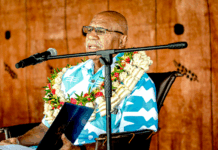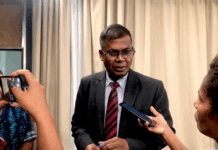
For years news media bosses warned the creaking business model backing journalism would fail at a major local outlet. It finally happened this week when Newshub’s owners proposed scrapping it. Then TVNZ posted losses prompting warnings of more cuts to come there. Can TV broadcasters pull a crowd without news? And what might the so-far ambivalent government do?
After Warner Bros Discovery top brass broke the bad news to staff on Wednesday, Newshub at 6 that night became a news event in itself.
RNZ MEDIAWATCH: By Colin Peacock, RNZ Mediawatch presenter
After Warner Bros Discovery top brass broke the bad news to staff on Wednesday, Newshub at 6 that night became a news event in itself.
In her report, political reporter Amelia Wade reminded viewers more than 30 years of TV news and current affairs — spanning the entire period of commercial TV here — could come to an end in June.
Before TV3 launched in 1989, state-owned TVNZ had been the only game in town.
But for most of its recent history, TV3’s parent company MediaWorks was owned by private equity funds and it was hamstrung with debts.
There were periodic financial emergencies too which seemed to signal the end.
In 2015, the boss Mark Weldon axed the current affairs shows Campbell Live and 3D and replaced them with ones that didn’t pull in more viewers or pull up many trees with their reporting.
“Reports of our death at 6pm have been greatly exaggerated”, host Hilary Barry responded to reports 3 News might be for the chop the following year.
But Weldon persuaded the owners to stump up a significant sum to launch Newshub instead.
When the huge global company Discovery bought MediaWorks loss-making TV channels in December 2020, many in the media were pleased a major media outfit was now in charge.
Using the Official Information Act, Newsroom later reported the Overseas Investment Office fast tracked Discovery’s application and sought no guarantees of a commitment to local news.
The 2021 mega-merger in the US that turned it into “Warner Bros Discovery” excited The Spinoff founder Duncan Grieve.
“Tova O’Brien breaking stories on CNN NZ at 6pm, before an evening of local reality TV souped up by global budgets and distribution — with major sports and drama rights for good measure,” was one scenario.
“It could also swing the other way, with the New Zealand linear asset seen as too small and obscure,” he warned.
After losses including a $35 million one last year, the owners now “propose” to slice out the entire on-screen and online news operation. New Zealand could lose more than 15 percent of its full-time journalists in one go.
Beginning of the end?

“Oh, the irony, right? When those so-called ‘vulture funds’ had it, the operation still continued, albeit always run on the smell of an oily rag. Then a big media organisation was the one which axed it,” long-serving TV3 current affairs journalist Eugene Bingham told Mediawatch.
“I’ve been around long enough to see death by a thousand cuts over the years. But this was a moment we’ll look back on as a watershed moment in democracy and journalism,” Bingham said.
Former MediaWorks executive Andrew Szusterman told RNZ’s Morning Report the next day this decision would also ripple out to local drama and entertainment.
“We’re going to start to see how this is going to impact the production sector. Irrevocably, possibly,” said Szusterman, now the chief executive at production company South Pacific Pictures.
Does Newshub’s demise also kill off Three?

There’s been no shortage of people this week pointing out the appetite for TV news — and linear TV in general — is not what it was. That’s the main reason for the ad revenue slump cited by WBD.
Some who do tune in to Three (and WBD’s other channels) for The Block, Married at First Sight and free movies may not miss the news shows from June 30. So maybe Three will be fine?
“The loss of the newsroom represents the loss of the ability to respond to any event in real time. That is the heart and soul of a traditional TV broadcaster,” Hal Crawford — chief news officer at MediaWorks (and effectively Newshub’s boss) until early 2020 — told Mediawatch.
“When the Queen dies you can send a team to London, you can have someone in the studio talking about it, you can interact in a way that makes people feel like it is alive and a real human entity.”

Channels without the live element news brings are effectively just “content databases”, Crawford told Mediawatch.
“News is the one programme that runs 365 days a year . . . which the schedule is going to rely on to lead into prime time. So the rest of your schedule is going to dwindle. Ratings are gonna fall off and everything is going to go to pieces.
“It really is going to dwindle as a cultural entity in New Zealand because you’re not going to be able to justify the funding from NZ on Air if you aren’t getting audiences. It’s hard for me to see a way out of Three basically going away as a cultural force in New Zealand.”
But TV-style news and current affairs is also now being done online.
After Eugene Bingham’s TV3 show 3D was axed in 2016, four members formed the Stuff Circuit investigative team. Its video documentary productions won awards until it was axed by Stuff late last year.
“Of course, there have been changes in viewing habits . . . but there’s still a reason that the ‘1’ and the ‘3’ on remotes around the country are worn down. Hundreds of thousands of people at six o’clock flip the channel. Without a TV bulletin there, doesn’t (Three) just become like Bravo, where there’s just programmes running and you either switch on or you don’t?”
In the end, journalists have to confront the fact that not quite enough people these days care about what they do — including executives at media companies, politicians not inclined to intervene and members of the public.
Most New Zealanders are happy to use services like Netflix or Google search or Facebook that carry news and local content but contribute almost nothing to it.
“But I don’t think people quite understand the depth of the problem facing media and the implications. That certainly came through to me watching the broadcasting minister saying, well, people can still watch programmes like Sky for news,” Bingham said.
The National Party went into the last election without a media or broadcasting policy or any specific manifesto commitments.
What should/could the government do?

While Wednesday’s announcement shocked the 300-odd staff, the local chief executive Glen Kyne — close to tears on Newshub at 6 — told Newshub’s Michael Morrah he had known about the possibility since January.
The government also got a heads-up earlier this week.
Media minister Melissa Lee told reporters WBD made no requests for help, prompting Glen Kyne to tell Newshub WBD did ask both the current and previous government for assistance, such as a reduction in the multi-million dollar fee paid to state-owned transmission company Kordia.
Lee later clarified her comment but was firm that the government had no role to play because this was a case of a private company taking action because “their business model actually wasn’t working.”
On Morning Report, Andrew Szusterman disagreed.
“Channels 7,9 and 10, SBS, ABC, and Fox in Australia all run news services. I don’t think their government would let the last commercial free-to-air news broadcaster just walk away. The fact the broadcasting minister hasn’t fronted . . . it’s quite shameless,” he told RNZ’s Morning Report.
Stuff’s Tova O’Brien — who famously turned on her former employer MediaWorks on air in real time last year when it closed Today FM — called the minister’s response “cold and tone-deaf” and accused the government of a “glib shrug”.
That was partly because Lee’s first response to the Newshub announcement was to tell reporters: “There’s Sky as well, there’s a whole lot of other media about.”
Sky contracts Newshub to produce its 5.30pm free-to-air news bulletin — and Sky subscribers won’t find any locally-made news on Sky TV’s pay channels.
Lee should have known that. She was a programme-maker before she was an MP and was National’s spokesperson on broadcasting for years in opposition.
Lee declined all interview requests this week — including from Mediawatch — but did tell reporters at Parliament: “I wasn’t as articulate as I could have been. But I am taking this seriously.”
The PM told Stuff he is expecting an update at Cabinet on Monday. The media will be watching that space with pens and cameras poised.
There is legislation currently before a select committee which could compel the big online tech platforms to pay local producers of news for it.
In opposition, Lee opposed it and called it “literally a shakedown” in Parliament. (This weekend Facebook’s owner Meta announced it would not do any more deals with media under Australia’s News Media Bargaining Code, prompting a likely confrontation with the government there.)
“The government’s position on this will obviously take into account these latest developments in terms of the wider media landscape. This government is committed to working with the sector on ways to ensure sector sustainability, while still preserving the independence of a fourth estate and avoiding market interference,” Lee said in Parliament on Thursday when questioned.
The government already heavily intervenes in the market by overseeing the state-owned broadcasters and agencies — including TVNZ — and putting over a quarter of a billion dollars every year onto broadcasting, programmes and other content.
The former government also put $80 million over two years into Māori media content, partly in the expectation there might also be a new public media entity to broadcast it.
In 2019, Hal Crawford — boss of Newshub at the time — declared the New Zealand news media is broken.
His chief executive also urged the government to intervene. AM show host Duncan Garner switched the studio lights off as an on-air stunt.
Crawford is now a digital media consultant based in his native Australia. The broadcasting funding agency in NZ On Air hired him in 2021 to review its own spending of public money on the media.
“It’s not a good idea for governments to knee jerk and sponsor particular commercial companies in some sort of bailout,” he said.
“To give money to the people who are in financially the worst position is the most ineffective and unfair use of public money that I can think of. If the market is telling you that something isn’t wanted and needed, you have to listen to that.
“But it doesn’t mean that you have to always listen to the market and do things that have never been done before.”
He cites the Public Interest Journalism Fund which put $55 million into new content and created new jobs for cash-strapped news media companies.
Crawford’s fact-finding report on the planned PIJF in 2021 records media managers feared cuts and possible closures to come.
“Many of our interviewees believed that if an organisation could show that cuts were imminent, they should be able to apply for funded roles under the PIJF. Many saw the dangers in this non-incremental funding, but argued for exceptions in extreme circumstances. Although these arguments are compelling, Funding could evaporate quickly trying to keep the newsrooms of big commercial companies afloat if this became the primary aim of the fund.”
“Around the world and in New Zealand, there’s ample evidence that public funding of journalism is becoming more essential. There has to be a way there, because what we’re seeing with the the planned closure of Newshub is the end result of the factors that we’ve known about for at least a decade,” Crawford told Mediawatch.
“Direct subsidy from the government to a commercial newsroom isn’t going to work. The government has to find a way to sensibly finance news and structure it so that it doesn’t become a political football.”
This article is republished under a community partnership agreement with RNZ.















































